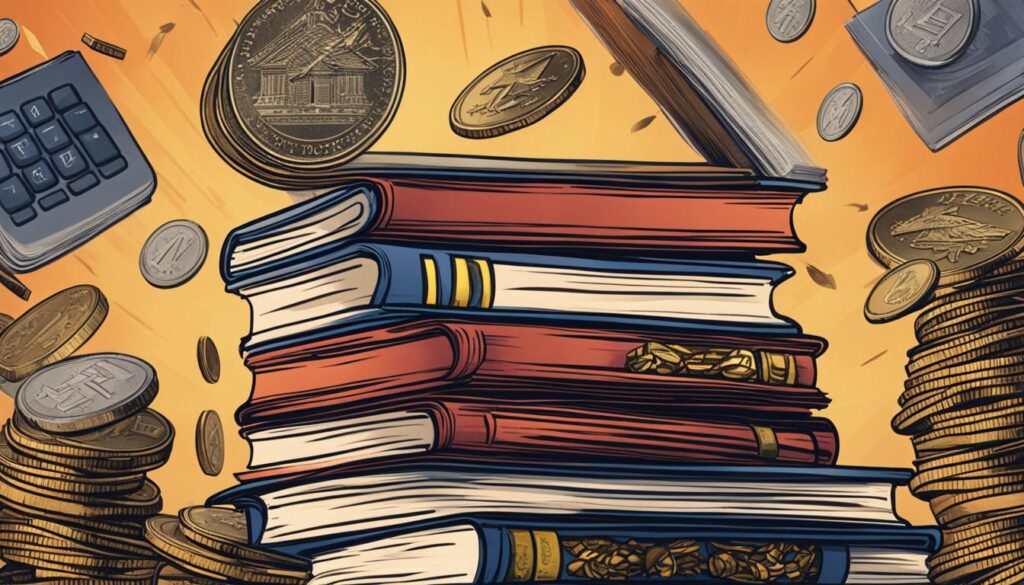Are you looking to save money on your mortgage? Refinancing your loan could be the solution you’ve been searching for. With tailored options that fit your unique needs, you can find the best refinance rates and start saving today.
Key Takeaways:
- Refinancing your mortgage can help you obtain a lower interest rate.
- By refinancing, you may be able to save money on your monthly payments.
- Consider different types of refinance loans to find the option that suits your financial goals.
- Shop around and compare offers from different lenders to find the best refinance rates.
- Weigh the pros and cons of refinancing before making a decision.
National Mortgage Interest Rate Trends
Mortgage interest rates have been on the rise since 2020 and 2021, reaching their highest point since 2000. As a result, refinances make up a smaller share of loans today. However, by refinancing your mortgage, you can still take advantage of lower interest rates and potentially save on monthly payments.
Mortgage Interest Rate Trends
To understand the impact of national mortgage interest rate trends, it’s important to look at the data. The table below provides an overview of the average 30-year fixed refinance APR and 15-year fixed refinance APR over the past few years.
| Year | 30-Year Fixed Refinance APR | 15-Year Fixed Refinance APR |
|---|---|---|
| 2019 | 4.08% | 3.64% |
| 2020 | 2.81% | 2.39% |
| 2021 | 2.98% | 2.40% |
| 2022 | 3.15% | 2.58% |
As shown in the table, mortgage interest rates have been relatively low in recent years, making it a favorable time to refinance. However, it’s important to keep in mind that rates can fluctuate, so it’s essential to stay informed and work with a reputable lender to secure the best refinance rates.

How Does Mortgage Refinancing Work?
Mortgage refinancing is a process that involves replacing your existing loan with a new one. It can be a strategic financial move that allows you to take advantage of lower interest rates, change the terms of your loan, or access the equity in your home.
When you decide to refinance your mortgage, you’ll need to go through a series of steps. First, you’ll need to undergo a credit check to assess your creditworthiness. This helps lenders determine the interest rate you qualify for. You’ll also need to provide financial documentation, including income verification and asset information.
Once you’ve completed the necessary paperwork, your lender will review your application and may require an appraisal of your property to determine its current value. If your application is approved, your new lender will pay off your existing mortgage, and you’ll start making monthly payments on the new loan.
The Refinance Process:
- Assess your financial goals: Determine why you want to refinance and what you hope to achieve. Whether it’s to secure a lower interest rate or access cash from your home’s equity, understanding your objectives is crucial.
- Research lenders and rates: Shop around and compare rates and terms from different lenders. Look for reputable lenders who offer competitive rates and favorable terms.
- Prepare your documentation: Gather all the required financial documents, such as tax returns, pay stubs, and bank statements. Having these ready will help streamline the application process.
- Submit your application: Complete the application form provided by your chosen lender. Double-check for accuracy and provide all the necessary information.
- Wait for approval: Your lender will review your application and assess your financial situation. They may request additional documentation or clarification during this process.
- Closing and funding: If your application is approved, you’ll need to sign the necessary documents to finalize the refinance. Your new loan will be funded, and you’ll start making payments according to the agreed-upon terms.
It’s important to note that the refinance process can vary depending on the lender and the type of loan you choose. Working with a knowledgeable mortgage professional can help guide you through the process and ensure you make informed decisions that align with your financial goals.
| Consideration | Explanation |
|---|---|
| Interest rates | Compare current interest rates to determine if refinancing can help you secure a lower rate, potentially reducing your monthly payments. |
| Loan term | Consider whether you want to extend or shorten your loan term. Extending the term may result in lower monthly payments, but you may end up paying more in interest over time. |
| Closing costs | Take into account the closing costs associated with refinancing. These costs can include application fees, appraisal fees, and attorney fees. Calculate if the potential savings outweigh the costs. |
| Equity | If you have built up equity in your home, refinancing can allow you to access that equity through a cash-out refinance. This can be useful for home improvements or consolidating debt. |
| Financial goals | Consider your long-term financial goals and how refinancing fits into them. Whether it’s reducing monthly payments, paying off your loan faster, or accessing cash, ensure refinancing aligns with your objectives. |

How to Refinance Your Mortgage in 6 Steps
Refinancing your mortgage can be a smart financial move, helping you save money and achieve your homeownership goals. If you’re considering refinancing, follow these six steps to navigate the process smoothly.
- Check your credit score: Before applying for a refinance loan, it’s important to know where you stand. A higher credit score can help you qualify for better refinance rates. Take the time to review your credit report and address any errors or issues.
- Choose a type of refinance loan: There are different types of refinance loans to suit various needs. Determine which option aligns with your financial goals. For example, a rate-and-term refinance is ideal if you want to lower your interest rate and adjust the repayment term, while a cash-out refinance allows you to access your home’s equity.
- Calculate the cost vs. savings: Consider the closing costs associated with refinancing and compare them to the potential savings. Use a refinance calculator to estimate your new monthly payments and how long it will take to recoup the upfront costs.
- Find the best refinance rates: Shop around and compare offers from different refinance mortgage lenders. Look for competitive rates, favorable terms, and reputable lenders. Take the time to request quotes and negotiate with lenders to secure the best deal.
- Gather required paperwork: Prepare the necessary documents for your refinance application. This typically includes tax returns, pay stubs, bank statements, and other financial records. Having these documents ready can help expedite the approval process.
- Prepare for closing: Once your refinance loan is approved, you’ll need to prepare for the closing process. Be aware of any additional requirements or preparations needed, such as scheduling a home appraisal or providing additional documentation. Stay in close communication with your lender to ensure a smooth closing.
Following these steps can help you navigate the mortgage refinance process effectively and increase your chances of securing the best refinance rates. Remember to carefully consider your financial circumstances and goals before proceeding with a refinance, and consult with a trusted financial advisor if needed.
Table: Top Refinance Mortgage Lenders
| Lender | Interest Rates | Loan Term | Loan Amount |
|---|---|---|---|
| ABC Mortgage | 2.75% | 15 years | $150,000+ |
| XYZ Bank | 2.85% | 30 years | $100,000+ |
| DEF Credit Union | 3.00% | 20 years | $200,000+ |
Note: The interest rates, loan terms, and loan amounts provided in the table are for illustrative purposes only. Actual rates and terms may vary based on individual financial profiles and lenders’ criteria.
Pros and Cons of Refinancing
Refinancing your mortgage or student loans can offer various benefits and drawbacks. It’s essential to consider both the pros and cons before making a decision. Here are some key factors to keep in mind:
Pros of Refinancing
- Lower interest rate: One of the main advantages of refinancing is the potential to secure a lower interest rate, which can result in significant savings over the life of your loan.
- Reduced monthly payments: By refinancing, you may be able to lower your monthly payments, freeing up extra cash in your budget.
- Elimination of PMI: If you have built up enough equity in your home, refinancing can help you eliminate private mortgage insurance (PMI) payments, further reducing your monthly costs.
- Access to home equity: Refinancing can provide an opportunity to tap into your home’s equity, allowing you to fund home improvements, consolidate debt, or cover other financial needs.
Cons of Refinancing
- Closing costs: Refinancing typically involves various fees and closing costs, which can add up to a significant amount. It’s important to weigh these costs against the potential savings.
- Extended repayment period: Refinancing may extend the length of your loan term, which means you’ll be making payments for a longer period. This can result in paying more in interest over time.
- Potential additional interest: Depending on your refinancing options, you may end up paying more in interest overall, especially if you extend the repayment period or choose a higher interest rate.
Considering both the pros and cons of refinancing will help you make an informed decision that aligns with your financial goals and circumstances.

Should You Refinance Your Mortgage?
Deciding whether to refinance your mortgage is an important financial choice that requires careful consideration. While refinancing can offer potential benefits, it’s crucial to evaluate your unique circumstances and goals to determine if it’s the right move for you. Here are some factors to consider:
1. Interest Rate Savings: One of the main reasons people choose to refinance is to secure a lower interest rate. By refinancing at a lower rate, you can potentially save money on your monthly mortgage payments and over the life of the loan.
2. Loan Term Adjustment: Refinancing also allows you to change the term of your loan. If you’re looking to pay off your mortgage faster, you can refinance to a shorter term. Conversely, if you need to lower your monthly payments, you can extend the repayment period.
| Refinance Options | Pros | Cons |
|---|---|---|
| Rate-and-Term Refinance | Lower interest rate, potential savings, adjust loan term | Closing costs, potential longer repayment period |
| Cash-out Refinance | Access home equity, consolidate debt, potential savings | Closing costs, potential longer repayment period, higher loan amount |
| Streamline Refinance | Simplified application process, potential savings, adjust loan term | Specific eligibility requirements, potential closing costs |
3. Costs and Fees: It’s important to consider the costs associated with refinancing, such as closing costs, appraisal fees, and origination fees. These expenses can vary depending on the lender and the specific terms of your refinance loan.
4. Time Horizon: Think about how long you plan to stay in your current home. If you’re considering refinancing but anticipate moving in the near future, the cost of refinancing may outweigh the potential savings.
Ultimately, the decision to refinance your mortgage should align with your financial goals and circumstances. It’s recommended to consult with a trusted mortgage professional who can provide personalized advice based on your specific situation. By weighing the pros and cons and thoroughly evaluating your options, you can make a well-informed decision about whether or not to refinance your mortgage.

Refinancing student loans can be a smart financial move, providing you with the opportunity to save money and potentially pay off your debt faster. By replacing your existing loans with a new loan through a private lender, you may qualify for a lower interest rate, which can result in significant savings over time.
When considering refinancing options, it’s important to evaluate factors such as the loan size, current interest rate, and desired repayment term. Choosing a shorter repayment term can lead to higher monthly payments, but it can also maximize your overall savings by reducing the amount of interest you’ll pay. On the other hand, opting for a longer repayment term can result in lower monthly payments, but you may end up paying more in interest over the life of the loan.
Here is an example of how refinancing student loans can impact your savings:
| Loan Amount | Interest Rate | Repayment Term | Total Interest Paid |
|---|---|---|---|
| $36,406 | 6.5% | 10 years | $9,681 |
| $36,406 | 4.5% | 10 years | $6,595 |
As shown in the table, refinancing a $36,406 student loan from a 6.5% interest rate to a 4.5% interest rate can save you $3,086 in total interest paid over the life of the loan.
Before refinancing your student loans, it’s important to compare offers from different lenders and consider factors such as fees, prepayment penalties, and customer reviews. Look for lenders that offer competitive rates and favorable terms, such as SoFi Student Loan Refinancing, Earnest Student Loan Refinancing, and Citizens Bank Student Loan Refinancing. By carefully evaluating your options and selecting the right lender, you can make the most of your refinancing opportunity and achieve your financial goals.
How Much Can I Save by Refinancing Student Loans?
Refinancing your student loans can lead to significant savings over time. The amount you can save depends on several key factors, including the size of your loan, the current interest rate, and the repayment term you choose.
To illustrate the potential savings, let’s consider the following scenario:
| Loan Details | Original Loan | Refinanced Loan |
|---|---|---|
| Loan Size | $36,406 | $36,406 |
| Interest Rate | 6.5% | 4.5% |
| Repayment Term | 10 years | 7 years |
| Total Interest Paid | $13,590 | $7,345 |
In this example, by refinancing your $36,406 student loan from an original interest rate of 6.5% to a refinanced rate of 4.5% and reducing the repayment term from 10 years to 7 years, you could potentially save $6,245 in total interest paid over the life of the loan.
It’s important to note that the actual savings will vary depending on your individual circumstances. Factors such as your credit score, income, and debt-to-income ratio can also impact the interest rates and terms offered to you by refinancing lenders. To get a more accurate estimate of your potential savings, consider using an online refinancing calculator or consulting with a financial advisor.

By carefully evaluating your options and comparing offers from different refinancing lenders, you can make an informed decision that maximizes your savings and helps you achieve your financial goals.
Is Now a Good Time to Refinance Student Loans?
Refinancing federal student loans is generally not recommended at this time due to the current suspension of federal loan payments and interest through December 2022. However, for private student loan borrowers with high interest rates and improved credit scores, refinancing might be a viable option. It’s important to assess the interest rate environment and the available protections offered by private lenders before deciding to refinance student loans.

While federal student loans are currently on hold, private student loans are not subject to the same suspension. If you have private student loans with high interest rates, refinancing could potentially help you save money by securing a lower interest rate. However, before making a decision, it’s crucial to consider the current interest rate environment. If interest rates are high, it may be more beneficial to wait for them to decrease before refinancing.
Another factor to consider is the available protections offered by private lenders. Federal student loans come with certain borrower protections, such as income-driven repayment plans and loan forgiveness options. When refinancing with a private lender, these protections may no longer be available. It’s important to weigh the potential savings from refinancing against the loss of these protections before making a decision.
In summary, it may not be the optimal time to refinance federal student loans due to the current suspension of payments and interest. However, for private student loan borrowers with high interest rates and improved credit scores, refinancing could be a potential option. Carefully evaluate the interest rate environment and the protections offered by private lenders to make an informed decision about refinancing your student loans.
What to Look for When Refinancing Student Loans
When considering refinancing your student loans, it’s important to find a reputable lender that offers favorable terms and competitive rates. Here are some key factors to consider when looking for a refinancing lender:
Loan Rates and Terms
Compare the interest rates and terms offered by different lenders. Look for lenders that offer low fixed interest rates or variable rates that are lower than your current loan. Consider the repayment term options and choose one that aligns with your financial goals. Longer terms may result in lower monthly payments but higher total interest paid over time.
Application and Origination Fees
Some lenders charge application or origination fees when refinancing student loans. These fees can add to the overall cost of refinancing, so it’s important to find lenders that offer zero or low fees. Look for lenders that prioritize transparency and have minimal fees.
Prepayment Penalties
Check if the refinancing lender imposes any penalties for prepaying your loan. Some lenders charge fees if you pay off your loan early, which can limit your flexibility to make extra payments and save on interest. Choose a lender that allows you to make prepayments without any penalties.
Customer Service and Support
Consider the level of customer service and support provided by the lender. Look for lenders that offer responsive customer service, online account access, and educational resources to help you make informed decisions. Good customer service can make the refinancing process smoother and more enjoyable.
| Lender | Interest Rates | Application Fee | Origination Fee | Prepayment Penalty | Customer Service |
|---|---|---|---|---|---|
| SoFi Student Loan Refinancing | Starting at 1.99% | No application fee | No origination fee | No prepayment penalty | 24/7 support and career coaching |
| Earnest Student Loan Refinancing | Starting at 2.15% | No application fee | No origination fee | No prepayment penalty | Personalized support and easy online account access |
| Citizens Bank Student Loan Refinancing | Starting at 2.39% | No application fee | No origination fee | No prepayment penalty | 24/7 customer support and online tools |
By choosing a reputable lender that offers favorable terms, low fees, and excellent customer service, you can maximize your potential savings and have a positive refinancing experience.

Conclusion
Refinancing your mortgage or student loans can be a smart financial move that can save you money and improve your overall financial situation. By securing a lower interest rate through a mortgage refinance, you can reduce your monthly payments and potentially save thousands of dollars over the life of your loan. Similarly, refinancing your student loans can help you qualify for a lower interest rate, resulting in significant savings over time.
However, before making the decision to refinance, it is crucial to carefully evaluate the costs and benefits involved. Consider factors such as the length of time you plan to stay in your home, the fees associated with refinancing, and the potential impact on your long-term financial goals. Consulting with a trusted financial advisor can help you assess whether refinancing is the right choice for you.
Remember, whether you’re considering a mortgage refinance or refinancing your student loans, it’s important to choose reputable lenders with competitive rates and favorable terms. Take the time to research and compare your options to ensure you’re getting the best possible deal. By making an informed decision and weighing the potential savings against the costs, you can make the most out of your refinance loans and achieve greater financial flexibility and stability.
FAQ
What is mortgage refinancing?
Mortgage refinancing involves replacing your existing loan with a new one, generally to obtain a lower interest rate or change the loan terms.
How does refinancing a mortgage work?
When you refinance your mortgage, a new lender pays off your original mortgage, and you make monthly payments on the new loan. The process requires a credit check, financial review, and may involve additional costs.
What are the steps to refinance a mortgage?
The steps to refinance a mortgage include checking your credit score, choosing a type of refinance loan, calculating cost vs. savings, finding the best refinance rates, gathering required paperwork, and preparing for closing.
What are the pros of refinancing a mortgage?
Refinancing a mortgage can potentially lock in a lower interest rate, reduce monthly payments, eliminate private mortgage insurance (PMI), and allow you to tap into home equity.
What are the cons of refinancing a mortgage?
The cons of refinancing a mortgage include the costs associated with closing, potentially extending the repayment period, and paying more in interest over time.
Should I refinance my mortgage?
Whether you should refinance your mortgage depends on factors like securing a lower interest rate, consolidating debt, eliminating PMI, and aligning with your financial goals. Consider the costs, how long you plan to stay in your home, and your overall financial strategy.
What is student loan refinancing?
Student loan refinancing involves replacing your existing loan(s) with a new one through a private lender, potentially saving money by qualifying for a lower interest rate.
How much can I save by refinancing student loans?
The amount you can save by refinancing student loans depends on factors such as loan size, current and new interest rates, and chosen repayment term. Calculating potential savings based on your specific situation is crucial.
Is now a good time to refinance student loans?
Refinancing federal student loans is generally not recommended at this time due to the current suspension of federal loan payments and interest through December 2022. However, for private student loan borrowers with high interest rates and improved credit scores, refinancing might be a viable option.
What should I look for when refinancing student loans?
When refinancing student loans, look for lenders that offer zero application or origination fees, as well as no penalties for prepayment. Consider reputable refinancing lenders that offer competitive rates and favorable terms.
